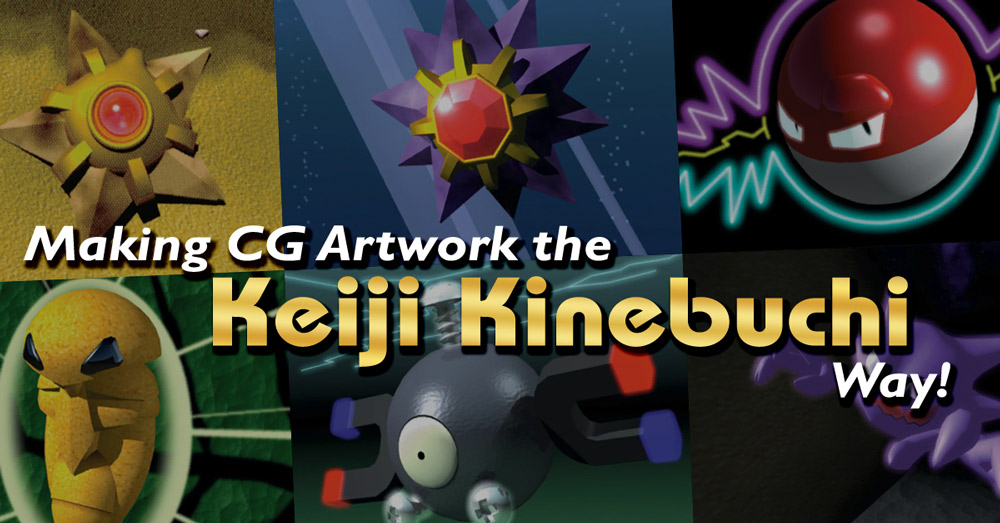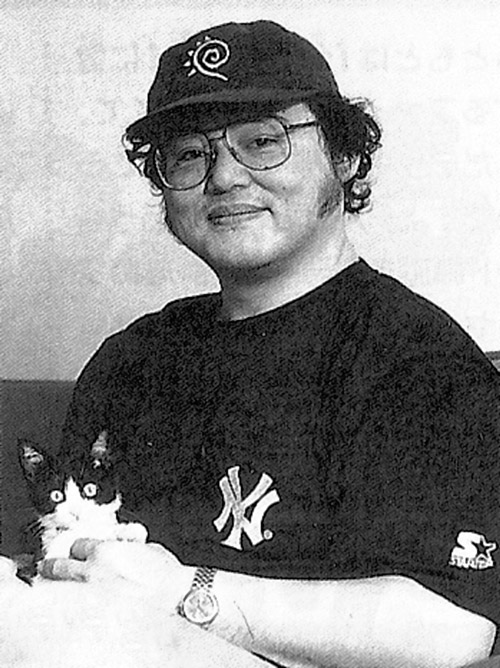
(This is still a work in progress!)
So in the early years of the Pokémon TCG, the few 3D pieces that exists were ALL done by Keiji Kinebuchi (1956-2002; RIP IN PEACE). Now whether or not you feel his artwork has aged well, you can’t deny how much his CG art has had a significant influence on the way the Pokémon TCG looks and feels today. Like all CG print artwork from the mid-1990s, it has a certain je ne sais quoi that is hard to replicate on modern CG programs, though it’s not to say people haven’t tried!
So what if you want to replicate his art style? Or at least want to know what Keiji used to produce his artwork back then? Well, this is where I’ll collect all the info I can about Keiji’s potential pipeline and try to use it to create my own era-authentic artwork. This entire journey will take some time, but I do want to at least get some basic questions answered right away. Some of this info was also pulled from the Keiji Kinebuchi discussion thread over at Elite Fourum; specific posts will be credited as well.
…
Right now this is just a stream of consciousness thing, but I’ll get it all organized in due time. I also plan on having a full in-depth tutorial covering this, so keep an eye out for that as well!
- Keiji Kinebuchi almost certainly used LightWave 3D for all of his CG artwork.
- Source? The picture to the right showing Keiji Kinebuchi wearing a cap with the LightWave 3D logo; he probably got that as part of a promotion deal when he bought LightWave 3D v4.0, perhaps to showcase that LightWave 3D had been spun off from Video Toaster (which it originally was part of).
- More specifically, he probably started with the Amiga version, then transitioned to the Windows NT version later on and likely stuck with that one until his passing in 2002.
- That said, GameFreak and Creatures were likely knee-deep in the Classic Mac ecosystem, and there was a Mac version for LightWave 3D released in mid-1990s, so there’s a good chance that they used the Mac version at GameFreak/Creature’s offices so that Keiji could work in-house or at least show off his artwork.
- LightWave 3D still exists to this day! Buuuutttt…. I wouldn’t use the modern version to try to remake the style of the mid-90’s. Even though modern CG creation tools are objectively more powerful, the vibe of mid-90’s CG artwork comes from a number of features (or lack thereof):
- Simplistic shaders which create a glossy, plastic look to everything
- Hard lighting and no global illumination = hard shadows
- Lack of “Sky & Sun” system, and thus a lack of difuse lighting systems; rather, all lights came from either a point light, spot light, or universal source, or used specific shaders to produce a glowing effect
- Limited use of image maps; objects were either flat colors or had procedurally generated textures
- No complex systems like hair or fog… hair was either a single shape or extruded objects, while fog just played with the transparency of other objects
- Low-poly meant more jaggies; smooth corners were tough to pull off unless it could be mathematically defined..
- In fact, ironically, the math-based modeling used in older CG programs—relative to modern vertice-based modeling—gives older CG MORE resolution than today, which is why older CG looked to SMOOOOOTH… but also why everything looks like it was designed using primitives (spheres, cylindars, torus, etc… nothing extruded).
- All of these are “quality of life” matters which were quashed in later and later versions, but in doing so, slowly eliminated that look-and-feel of the old styles. Because of the literally different way CG was rendered, it’s near impossible to recreate in modern CG software without using very deliberate plugins and techniques. Think of it like trying to replicate your childhood crayon drawings on printer paper using oil and canvas.
- What versions of LightWave 3D did Keiji use? Almost certainly he used versions v3.x through v6.x (covering 1993 through 1999), and it seems like he did a pretty good job of keeping up-to-date with releases.
- v3 (1993) — part of the Video Toaster suite, but rather bare bones relative to later versions; this version is the ones with the rough, plasticky, limited textures look-and-feel
- v3.5 (1994) — first version to be independent from Video Toaster, but still mostly Amiga-based
- v4 (1995) — first version to be for non-Amiga systems (namely Windows NT); has a more transitional CG style with more polished lighting… it looks like that this version was what Keiji used to make the original CG artwork for Base Set and Jungle, particularly Clefairy Doll, PlusPower/Defender/Speeder and the Oddish/Gloom/Vileplume line
- v5 (1995) — has a more robust lightning and rendering system, including motion blur, which was more ideal for broadcast-level visuals (like the ones used in Babylon 5 or ReBoot) and was the first version available for Macs; it’s possible that Keiji moved to this one for everything he made from Fossil through Neo Genesis at least
- v6 (1999) — the last version released in the 90’s, which added a whole renderer; most likely this was used to create the cards used in Neo Revelations and Neo Destiny.
- That said, it’s hard to tell 100% because some cards—like EXP.ALL and Grimer —look older than something like Rocket’s Hideout and Voltorb, so for all we know some artwork was created using older versions of LightWave but never used until these later cards.
- But CG alone wasn’t the whole picture; Keiji also almost certainly used other apps like Adobe Photoshop to help compose his pieces.
- Unlike CG apps which have had changed/upgraded features over the years, Photoshop is has remained surprisingly consistant; for example, a lot of the Distort filters still use the same interfaces used since the 1990s (if it ain’t broke, don’t fix it!)
- For example, he would have designed certain surface textures within Photoshop to import within LightWave 3D (such as the graffiti in the background of Gastly), and then—after rendering—used Photoshop to add or composite different elements together.
- So what can you do to run the mid-90’s CG software—not just LightWave 3D but also Maya, Infini-D, Strata StudioPro, Bryce 3D—nowadays? It’s a bit complex, especially depending on which OS version you’re trying to run it on.
- Amiga? Forget ever owning an actual Amiga, they sell for almost $1000+ nowadays, due to their rarity and nostalgia. You’re better off running an Amiga emulator like WinUAE and finding a ready-to-go LightWave 3D Amiga hard drive image. Other things to consider include:
- A proper Kickstart ROM + Workbench 3.1/3.5
- A Video Toaster image, or a standalone LightWave 3.x or 4.0 ADF/LHA install
- There is also the PiMiga route, which is a Linux-based Amiga emulator that can run on a Raspberry Pi 4; here’s a video showing PiMiga running LightWave 3D, while this page covers download and installation instructions.
- Windows NT? While Windows 11 is technically still part of the Windows NT family, and the old software is technically 32-bit… Windows 11 lacks a lot of the DLLs and other key software that older programs need. Instead, you’ll need to run an NT emulator like PCem or 86Box, which should reproduce the Windows NT 4.0 environment and necessary CPU/GPU requirements for LightWave 3D v5.x/6.x and other era-appropriate CG programs.
- You can also build a modern-era x86 box, such as this build from LGR or this one covered by Modern Vintage Gamer… technically those two run Windows 98, but I’m sure you can get them to run Windows NT 4.0.
- Classic MacOS 8/9? You can emulate Classic MacOS, though it won’t be as powerful as running it on actual hardware. Thankfully actual Classic MacOS hardware is relatively inexpensive… you can find a ton of various Apple Mac G4 systems—G4 tower, iMac, Mac Mini—on eBay for relatively cheap (US$150), and they can all run Classic MacOS (either natively or using the Classic environment within MacOS X). This should allow you to run all the best Classic Mac CG software without headaches… though you might want to consider swapping out the internal platter hard drive with an SSD (I recommend ZuluSCSI or BlueSCSI for older Mac versions using SCSI drives).
- Software itself? I’m not gonna share specific links, but there’s always a ton of great era-appropriate software if you know where to look! That said, the versions you should keep an eye out for include:
- LightWave 3D: the primary versions used for the 1990s timeframe were versions 3 through 6, according to the official LightWave 3D version history page; that said, it appears versions 3 through 5 used the same base rendering system but simply added extra features, whereas v6 overhauled the renderer and thus had a noticibly different look. The computers you can use these versions on include:
- v3.0 = Amiga only (needs Video Toaster hardware, but it can be bypassed)
- v3.5 = Amiga only (first standalone product without requiring Video Toaster hardware)
- v4.0 = Amiga, Windows NT, DEC Alpha
- v5.0 = Amiga (last compatible version), Windows NT, DEC Alpha, SGI, Apple Macintosh
- v6.0 = Windows NT, Apple Macintosh, DEC Alpha, SGI (the latter two maybe? I didn’t see any info confirming or denying that)
- Adobe Photoshop: coincidentally, the versions of Photoshop used around the same time was also versions 3 through 6, covering 1994 through 2000. Even though each version added features, the core features used back in v3 remained the same, so you can probably just get away with using whatever is the maximum version that your system—emulated or original—can handle.
- LightWave 3D: the primary versions used for the 1990s timeframe were versions 3 through 6, according to the official LightWave 3D version history page; that said, it appears versions 3 through 5 used the same base rendering system but simply added extra features, whereas v6 overhauled the renderer and thus had a noticibly different look. The computers you can use these versions on include:
- Amiga? Forget ever owning an actual Amiga, they sell for almost $1000+ nowadays, due to their rarity and nostalgia. You’re better off running an Amiga emulator like WinUAE and finding a ready-to-go LightWave 3D Amiga hard drive image. Other things to consider include:
- What if you’re on a budget and/or you don’t know how to install emulators? Well, there are free ways to use modern CG programs like Blender and tailor them to replicate that classic style.
- This video by “SunnyIsOnline” has a great breakdown of how to use Blender’s tools to replicate the 1990’s look
- This video by Christian Fraiser also goes over how to replicate that look using Blender
- Remember, Blender is 100% free!
Until I start actually covering what I do to get LightWave 3D running—I’m still debating whether going Amiga, NT or Mac routes—here’s a few useful videos showcasing CG apps from the mid-90’s… maybe one of these are going to be more up your alley?
MacAddict Magazine Issue #3 (November 1996) covering various 3D tools available for the Classic Mac:
That’s all the notes I have so far… but keep an eye out on this page for further updates as I learn more about how to make Keiji Kinebuchi-style 1990’s-era artwork using LightWave 3D!
And if you found these notes useful on your own CG design journey, I would certainly appreciate it if you could visit my Ko-Fi page and buy me a coffee or other adult beverage!


